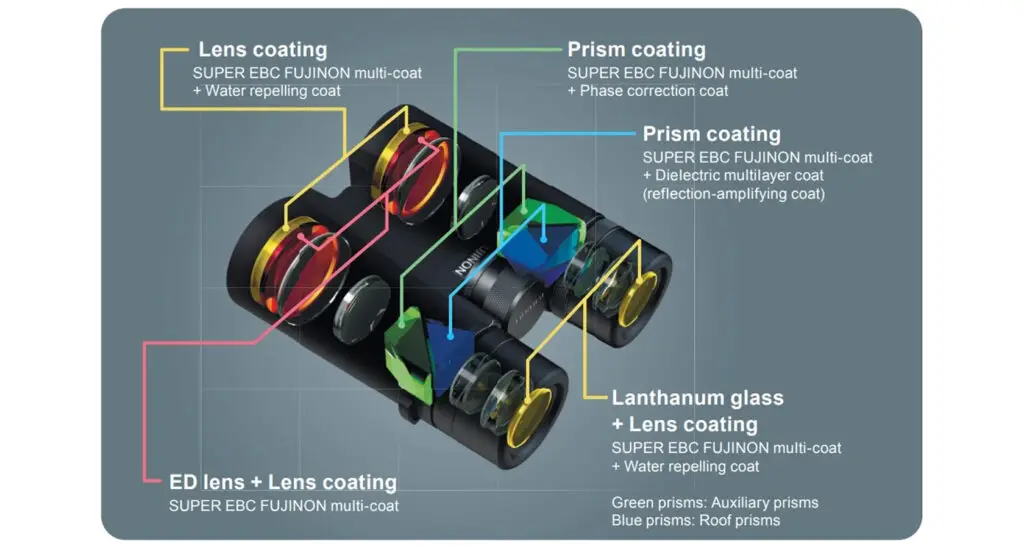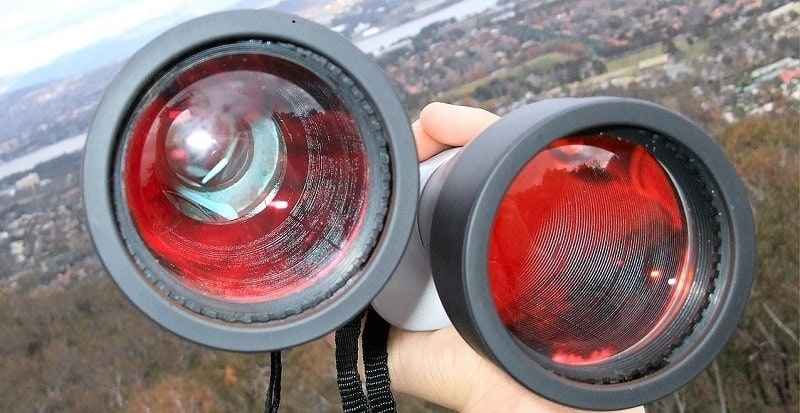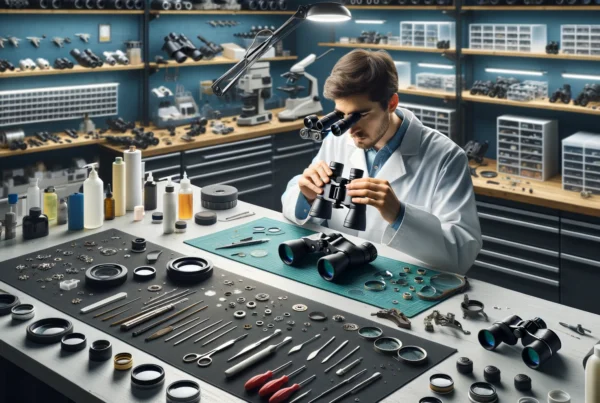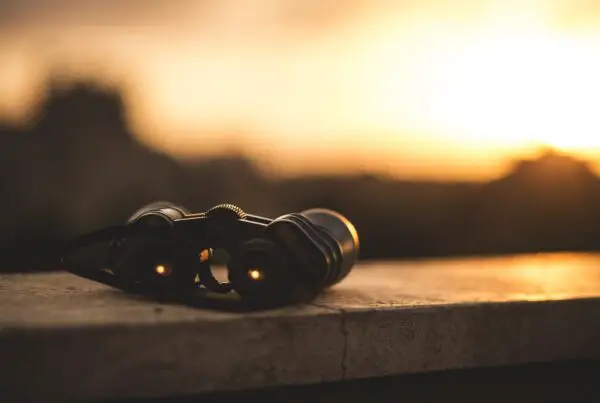Contents
Are you an outdoor enthusiast, a birdwatcher, a stargazer, or simply someone who enjoys the beauty of the world through the lens of binoculars? If so, you might have come across terms like “prism coatings” that promise to enhance your viewing experience.
Binoculars use prisms to correct the orientation of the image and provide a more compact design. Two types of coatings are commonly used on these prisms: silver coating and dielectric coating.
In this article, we will explore the differences between these two coatings and their impact on the performance of binoculars.
Silver Coated Prisms
Silver coating is a metallic coating applied to the reverse side of a prism surface that is not totally reflective to raise the reflectivity of the prism mirror surface. Silver-coated prisms are more reflective than aluminum-coated prisms and can have reflectivity in the high 90% range.

Silver-coated prisms look brighter and white when aiming, while copper-coated prisms look orange. However, silver coatings can deteriorate over time, which can affect the performance of the binoculars.
Advantages of Silver Coated Prisms
- Affordability: Binoculars with silver-coated prisms are generally more budget-friendly compared to those with dielectric coatings. They offer a good balance of performance and cost.
- Decent Light Transmission: In well-lit environments, silver-coated prisms provide satisfactory light transmission, making them suitable for various daytime activities.
- General Purpose Use: Silver-coated prism binoculars are versatile and well-suited for general observations, including wildlife viewing, sports events, and outdoor adventures.
Limitations of Silver Coated Prisms
- Lower Light Transmission: In low-light conditions, such as dawn or dusk, silver-coated prisms may not deliver the same level of brightness and image clarity as dielectric coatings.
- Susceptible to Wear: The silver coating can degrade over time, particularly when exposed to harsh environmental conditions, affecting the long-term optical performance.
Dielectric Coated Prisms
Dielectric coating is a high-reflectivity prism coating that provides high reflectivity across the entire range of visible light and acts as a dielectric mirror, thus providing both sharper colors and crisper images. Dielectric reflective coatings reflect more light than silver or aluminum mirrors.

Roof prisms should feature dielectric mirror and phase correction coatings. Broadband dielectric-coated right-angle prisms are ideal for near-normal and 45° reflections. They perform well with both S- and P-polarized light over a wide wavelength range.
Advantages of Dielectric Coated Prisms
- Superior Light Transmission: Dielectric coatings are highly efficient at transmitting light, ensuring brighter and clearer images, especially in low-light conditions.
- Enhanced Image Clarity and Contrast: With improved light transmission, dielectric-coated prisms deliver sharper, more detailed images with higher contrast, allowing you to discern finer details.
- Ideal for Astronomy and Low-Light Activities: Stargazers and wildlife enthusiasts will appreciate the excellent performance of dielectric-coated prism binoculars, especially during dimly lit hours.
Limitations of Dielectric Coated Prisms
- Higher Cost: The advanced technology and materials used in dielectric coatings result in higher manufacturing costs, making binoculars with these coatings more expensive.
Choosing the Right Prism Coating: Considerations
Selecting the ideal prism coating largely depends on your intended use, preferences, and budget.
- Budget Considerations: If you’re on a tight budget and primarily engage in daytime activities, silver-coated prisms can offer a compelling option.
- Low-Light Enthusiasts: If you’re passionate about stargazing, birdwatching at dawn, or any other low-light activity, dielectric-coated prisms are your best bet for unparalleled performance.
- Long-Term Investment: If you’re looking for long-lasting optical excellence, dielectric coatings are known for their durability and resistance to environmental wear.
Which Coating is Better?
Dielectric coatings are generally considered to be superior to silver coatings in terms of performance. They provide higher reflectivity, sharper colors, and crisper images.
However, they are also more expensive than silver coatings. The choice between the two coatings ultimately depends on the intended use of the binoculars and the budget of the user.
Frequently Asked Questions
Here are some frequently asked questions (FAQs) and answers about using an air fryer for the first time:
What are prism coatings in binoculars, and why are they essential?
Prism coatings are specialized optical coatings applied to the prism surfaces inside binoculars. They play a crucial role in enhancing the optical performance of binoculars by reducing internal reflections and increasing light transmission. Prism coatings improve image brightness, clarity, and contrast, providing users with a superior viewing experience.
What is the main difference between Silver Coated and Dielectric Coated prism coatings?
The main difference lies in the materials used and their light transmission capabilities. Silver Coated prism coatings involve applying a thin layer of metallic silver to the prisms, offering decent light transmission and affordability. On the other hand, Dielectric Coated prism coatings use multiple layers of dielectric materials, providing superior light transmission, enhanced image clarity, and better performance in low-light conditions. However, dielectric coatings are generally more expensive.
Which type of prism coating is better for stargazing and low-light activities?
Dielectric Coated prism coatings are the preferred choice for stargazing and low-light activities. Their excellent light transmission and enhanced image brightness make them ideal for observing celestial objects and wildlife during dawn, dusk, or nighttime.
Do Silver Coated prism coatings work well in bright daylight and well-lit environments?
Yes, Silver Coated prism coatings are suitable for well-lit environments and daytime activities. They provide satisfactory light transmission in such conditions and are well-suited for general-purpose use, such as wildlife observation and sports events during the day.
Are Dielectric Coated prism coatings worth the extra cost?
The decision to opt for Dielectric Coated prism coatings depends on your preferences and intended use. If you value superior optical performance, especially in low-light conditions, and are willing to invest in a premium viewing experience, dielectric coatings are definitely worth the extra cost.
How do I clean and maintain binoculars with prism coatings?
Proper maintenance is essential to preserve the effectiveness of prism coatings. Use a soft, lint-free microfiber cloth and specialized lens cleaning solution to gently wipe the prism surfaces. Avoid using harsh chemicals, rough materials, or excessive force during cleaning, as they can damage the coatings.
Can prism coatings wear off over time?
Silver Coated prism coatings may degrade over time due to exposure to environmental factors, potentially impacting the optical performance of binoculars. Dielectric Coated prism coatings, on the other hand, are known for their durability and resistance to wear, offering long-lasting optical excellence.
Are there any specific activities that benefit more from one type of prism coating over the other?
Yes, certain activities benefit more from a particular type of prism coating. For general outdoor observations during daylight hours, Silver Coated prism coatings provide satisfactory performance. However, if you engage in stargazing, birdwatching during low-light hours, or any activity where light conditions are challenging, Dielectric Coated prism coatings deliver superior results.
Can I upgrade prism coatings on my existing binoculars?
Prism coatings are applied during the manufacturing process and cannot be easily upgraded or changed on existing binoculars. If you desire the benefits of Dielectric Coated prism coatings, you may need to consider purchasing new binoculars with the desired coating.
How do I choose the right prism coating for my specific needs?
To choose the right prism coating, consider your intended use, budget, and the lighting conditions in which you’ll primarily use the binoculars. If you require excellent low-light performance and are willing to invest in premium optics, Dielectric Coated prism coatings are the way to go. For general-purpose use and affordability, Silver Coated prism coatings offer a compelling option.
To Conclude
Silver coatings and dielectric coatings are the two most common types of coatings used on prisms. While silver coatings are less expensive, dielectric coatings provide superior performance. When choosing binoculars, it is important to consider the type of prism coating used and its impact on the overall performance of the binoculars.

A Binoculars enthusiast, who love exploring skies and watching birds. It is my hobby to collect Binoculars of different kinds and try to explore the world through various lenses. This is all I do to explore happiness by magnifying my beautiful world.




